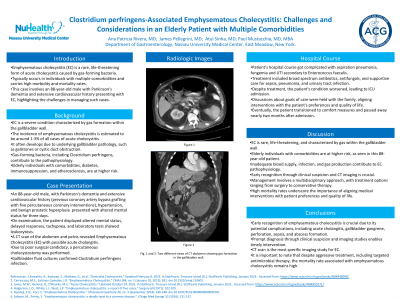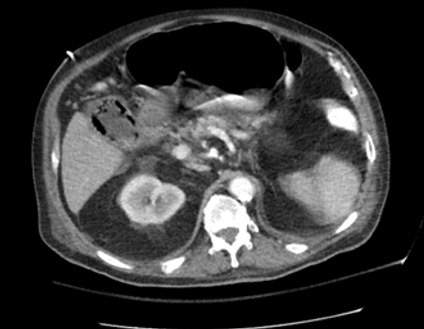Tuesday Poster Session
Category: Biliary/Pancreas
P2903 - Navigating the Complexity of Emphysematous Cholecystitis: Insights from a Challenging Case in an Elderly Patient
Tuesday, October 24, 2023
10:30 AM - 4:00 PM PT
Location: Exhibit Hall

Has Audio

Ana P. Rivera Arauz, MD
Nassau University Medical Center
East Meadow, NY
Presenting Author(s)
Ana P. Rivera Arauz, MD, James Pellegrini, MD, Atul Sinha, MD, Paul Mustacchia, MD, MBA
Nassau University Medical Center, East Meadow, NY
Introduction: Emphysematous cholecystitis (EC) is a rare, life-threatening condition caused by gas-forming bacteria in the gallbladder. It usually occurs in patients with multiple comorbidities and has high morbidity and mortality rates. We present the case of an 88-year-old male with Parkinson's dementia and cardiovascular disease who developed EC. Despite aggressive treatment, his condition worsened, demonstrating the challenges of managing this condition.
Case Description/Methods: An 88-year-old male with Parkinson's dementia, prior CABG and multiple PCIs, hypertension, and BPH, presented with altered mental status, declining alertness, reduced appetite, and increased weakness over a three-day period. Physical exam showed delayed responses, tachypnea, and the CBC showed leukocytosis. CT abdomen/pelvis revealed Emphysematous cholecystitis, possible acute cholangitis, mild dilatation in hepatic ducts, and a localized fluid collection. Percutaneous cholecystostomy was performed due to poor surgical candidacy. Gallbladder fluid culture was positive for Clostridium perfringens. The hospital course was complicated by fungemia and worsening sepsis, likely resulting from multiple factors, including emphysematous cholecystitis, aspiration pneumonia, and UTI. The patient was treated with prolonged courses of broad-spectrum antibiotics and antifungal medications under the guidance of the Infectious Diseases team. However, due to the patient's unfavorable prognosis, advanced age, and decreased quality of life, the family decided to discontinue medical care and transition to comfort measures. The patient passed away approximately two months after being admitted.
Discussion: Emphysematous cholecystitis represents 1-3% of acute cholecystitis cases and has a high mortality rate, making it clinically significant, especially in elderly individuals with multiple comorbidities. Risk factors include diabetes, immunosuppression, and atherosclerotic disease. The pathophysiology involves inadequate blood supply, infection, and gas production within the gallbladder by bacteria, especially Clostridium perfringens. Early diagnosis is crucial to prevent complications. CT scan is the most specific imaging study for EC. Management involves a multidisciplinary approach, considering interventions like cholecystectomy or cholecystostomy. Surgical decisions should be based on individual factors, balancing risks, and benefits. In conclusion, early recognition, imaging, and multidisciplinary care are vital to improve outcomes.

Disclosures:
Ana P. Rivera Arauz, MD, James Pellegrini, MD, Atul Sinha, MD, Paul Mustacchia, MD, MBA. P2903 - Navigating the Complexity of Emphysematous Cholecystitis: Insights from a Challenging Case in an Elderly Patient, ACG 2023 Annual Scientific Meeting Abstracts. Vancouver, BC, Canada: American College of Gastroenterology.
Nassau University Medical Center, East Meadow, NY
Introduction: Emphysematous cholecystitis (EC) is a rare, life-threatening condition caused by gas-forming bacteria in the gallbladder. It usually occurs in patients with multiple comorbidities and has high morbidity and mortality rates. We present the case of an 88-year-old male with Parkinson's dementia and cardiovascular disease who developed EC. Despite aggressive treatment, his condition worsened, demonstrating the challenges of managing this condition.
Case Description/Methods: An 88-year-old male with Parkinson's dementia, prior CABG and multiple PCIs, hypertension, and BPH, presented with altered mental status, declining alertness, reduced appetite, and increased weakness over a three-day period. Physical exam showed delayed responses, tachypnea, and the CBC showed leukocytosis. CT abdomen/pelvis revealed Emphysematous cholecystitis, possible acute cholangitis, mild dilatation in hepatic ducts, and a localized fluid collection. Percutaneous cholecystostomy was performed due to poor surgical candidacy. Gallbladder fluid culture was positive for Clostridium perfringens. The hospital course was complicated by fungemia and worsening sepsis, likely resulting from multiple factors, including emphysematous cholecystitis, aspiration pneumonia, and UTI. The patient was treated with prolonged courses of broad-spectrum antibiotics and antifungal medications under the guidance of the Infectious Diseases team. However, due to the patient's unfavorable prognosis, advanced age, and decreased quality of life, the family decided to discontinue medical care and transition to comfort measures. The patient passed away approximately two months after being admitted.
Discussion: Emphysematous cholecystitis represents 1-3% of acute cholecystitis cases and has a high mortality rate, making it clinically significant, especially in elderly individuals with multiple comorbidities. Risk factors include diabetes, immunosuppression, and atherosclerotic disease. The pathophysiology involves inadequate blood supply, infection, and gas production within the gallbladder by bacteria, especially Clostridium perfringens. Early diagnosis is crucial to prevent complications. CT scan is the most specific imaging study for EC. Management involves a multidisciplinary approach, considering interventions like cholecystectomy or cholecystostomy. Surgical decisions should be based on individual factors, balancing risks, and benefits. In conclusion, early recognition, imaging, and multidisciplinary care are vital to improve outcomes.

Figure: CT abdomen demonstrating emphysematous cholecystitis.
Disclosures:
Ana Rivera Arauz indicated no relevant financial relationships.
James Pellegrini indicated no relevant financial relationships.
Atul Sinha indicated no relevant financial relationships.
Paul Mustacchia indicated no relevant financial relationships.
Ana P. Rivera Arauz, MD, James Pellegrini, MD, Atul Sinha, MD, Paul Mustacchia, MD, MBA. P2903 - Navigating the Complexity of Emphysematous Cholecystitis: Insights from a Challenging Case in an Elderly Patient, ACG 2023 Annual Scientific Meeting Abstracts. Vancouver, BC, Canada: American College of Gastroenterology.
